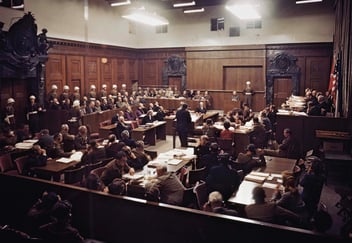The courtroom fell silent once more as Ahmad addressed a concept that had captured imaginations and ignited debates around the world: the Fourth Industrial Revolution (4IR). A term coined by global elites to herald an age of unprecedented technological advancement, 4IR promised to revolutionize industries, economies, and lives. But Ahmad's task was to pierce through the glittering veneer of progress and lay bare its consequences for humanity.
He began with a simple but profound statement. “Revolutions are rarely bloodless. They may not always spill literal blood, but they disrupt, displace, and redefine the very fabric of societies. The Fourth Industrial Revolution is no exception.”
The Promises of Progress
The proponents of 4IR spoke in glowing terms of its potential. Automation would reduce labor burdens, artificial intelligence would solve problems once deemed insurmountable, and biotechnology would unlock mysteries of the human body. It was a future of smart cities, autonomous vehicles, and infinite connectivity—a world in which technology would not merely serve humanity but integrate with it.
“Imagine,” Ahmad said, “a factory that never sleeps, a hospital where diseases are diagnosed by algorithms, and a city where every movement is tracked to ensure efficiency. This is the promise of 4IR. But what, I ask, is the price?”
He pointed out that these advancements, while extraordinary, came with a hidden cost. They demanded more than resources or investment; they required humanity itself as collateral.
The Human Cost of Automation
Central to 4IR was the promise of automation. Machines, fueled by artificial intelligence, would take over tasks once performed by humans, streamlining production and increasing efficiency. But Ahmad was quick to challenge this narrative of progress.
“Efficiency,” he argued, “is not synonymous with humanity. To replace human labor with machines is to strip individuals of purpose, of identity, of the dignity that comes from meaningful work.”
He painted a vivid picture of communities hollowed out by automation: factories once bustling with workers replaced by robotic arms, artisans rendered obsolete by 3D printers, and entire industries reduced to digital platforms. These changes, Ahmad contended, would not only erode economic stability but also fracture the social fabric.
“Without work,” he asked, “who are we? And who benefits when human hands are no longer needed?”
The Surveillance State
The courtroom listened intently as Ahmad turned to another hallmark of 4IR: the rise of smart technologies and the surveillance state. He described a world where every action, from purchasing groceries to walking down the street, was monitored and recorded.
“Data,” he declared, “is the currency of the Fourth Industrial Revolution. But unlike gold or money, it is extracted not from the earth but from our very lives. Every click, every movement, every heartbeat becomes a commodity to be bought and sold.”
He warned of the dangers of such a system, where control over data concentrated in the hands of a few could lead to unparalleled power. Governments and corporations, armed with algorithms, could predict and influence behavior, manipulate choices, and enforce conformity.
“What happens,” Ahmad asked, “when freedom is no longer a right but a privilege granted by those who control the systems that govern our lives?”
The Erosion of Human Connection
At the heart of Ahmad’s argument was the assertion that 4IR threatened to erode the very essence of human connection. In a world dominated by screens and algorithms, relationships would be mediated by technology, reducing the richness of human interaction to digital exchanges.
He spoke of children growing up in virtual classrooms, families communicating through screens, and friendships reduced to social media interactions. These changes, while convenient, came at the cost of authenticity and depth.
“The Fourth Industrial Revolution,” Ahmad said, “promises connection but delivers isolation. It brings us closer in proximity but distances us in spirit.”
A Call for Balance
Despite his critique, Ahmad was not a Luddite railing against progress. He acknowledged the potential of 4IR to solve pressing challenges, from healthcare to climate change. But he called for balance—a balance rooted in fitrah, the natural law that prioritizes humanity over machines.
“Technology,” he argued, “must serve humanity, not the other way around. Progress must be guided by principles of justice, dignity, and harmony.”
He urged the court, and by extension the world, to approach 4IR with caution and reflection. Policies must ensure that advancements do not come at the expense of human rights, and innovations must align with the values that define humanity.
The Verdict of History
As Ahmad concluded his argument, he posed a question that hung heavy in the room. “When historians look back on this revolution, what will they see? Will they see a world elevated by progress, or a humanity diminished by its own creations?”
The Fourth Industrial Revolution, Ahmad contended, was not inherently good or evil. It was a tool—a double-edged sword that could either enhance or undermine the human condition. Its legacy would depend on the choices made in its wake.
This chapter is not a condemnation of technology but a call to responsibility. It challenges humanity to wield its creations with wisdom and foresight, to ensure that the revolution it births is one of balance, not chaos. For in the end, the measure of progress is not in the machines we build but in the humanity we preserve.




